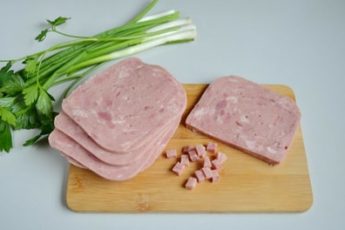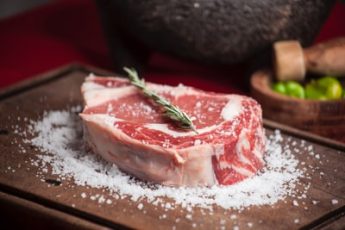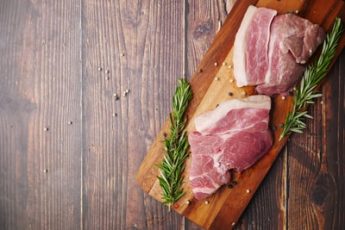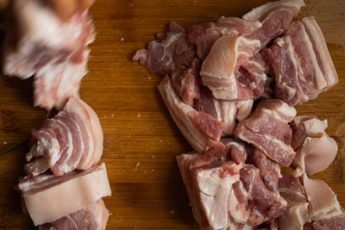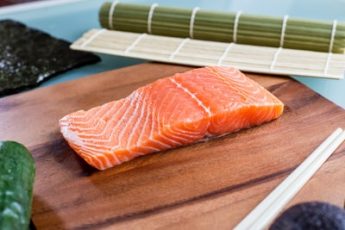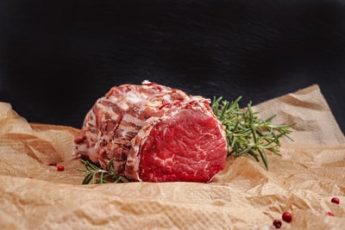Using a meat thermometer is a key ingredient to cooking a safe chicken. In addition to getting an accurate reading, a meat thermometer can help you cook chicken to the right temperature. This article will cover what a meat thermometer is, how to use it properly, and how to clean it.
When cooking chicken, the USDA recommends that the internal temperature be 165 degrees Fahrenheit. To determine how well cooked a chicken is, follow the following tips. Before starting your next cooking project, check the recommended internal temperature of chicken with a meat thermometer. This will help you make the perfect piece of chicken every time. Ensure the food is not overcooked or undercooked to avoid harmful bacteria. This infographic explains the importance of a meat thermometer and how it works.
Cooking poultry
| Image | Price | Buy | Prime | Title |
|---|---|---|---|---|
Top Top
Top | Buy Now | PrimeEligible | MEATER SE: Smart Bluetooth Meat Thermometer | Long Wireless Range | for Oven, Grill, Kitchen, BBQ, Smoker, Air Fryer | Step-by-Step Recipes in App | Dual Sensors | Black Charger [2024 Release] | |
 Top
Top | Buy Now | PrimeEligible | MEATER Pro: Smart Bluetooth Wireless Meat Thermometer Digital | 1000°F Heat Resistance | Long Range | Certified Accuracy | BBQ, Oven, Grill, Smoker, Air Fryer, Deep Fryer | 50+ Recipes in App | |
 Top
Top | Buy Now | PrimeEligible | MEATER Block: WiFi Smart Wireless Meat Thermometer | 4 Probes, Long Range | Perfect for BBQ, Oven, Grill, Kitchen, Smoker, Air Fryer | Apple Watch, Alexa Compatible | iOS & Android App | |
 Top
Top | Buy Now | PrimeEligible | Wireless Meat Thermometer Digital: Smart Multi Sensors Accuracy Bluetooth WiFi Food Thermometer with Ultra-Thin Probes for Cooking, BBQ,Oven, Grill, Smoker, Heat Resistance| Long Range| Fast Charging | |
 Top
Top | Buy Now | PrimeEligible | MEATER | The Original True Wireless Smart Meat Thermometer for the Oven Grill Kitchen BBQ Smoker Rotisserie with Bluetooth and WiFi Digital Connectivity | |
 Top
Top | Buy Now | PrimeEligible | ThermoPro TempSpike Plus 600FT Wireless Meat Thermometer with Upgraded Ultra-Thin Probe, Bluetooth Meat Thermometer Wireless for Outside Grill, Smoker Thermometer for BBQ Oven Rotisserie Sous Vide |
As an Amazon Associate we earn from qualifying purchases.
Using a meat thermometer when cooking poultry is a great idea for ensuring its internal temperature is the right one. There are different kinds of poultry and different cooking methods. Poultry is usually low-fat and requires minimal preparation, but this type of food can have problems with temperature accuracy because of bones and other structures. A digital thermometer, such as a ThermoPro digital thermometer, can help you achieve accurate and consistent temperatures for poultry. You can also use this type of thermometer to store temperature settings.
Meat thermometers come in both digital and dial versions. Digital models are usually inserted into the meat from outside the oven, giving an instant reading. Dial models can take up to 15 seconds to read the temperature. A thermometer with a red arrow pointing to the temperature can be inserted into the meat before cooking, and should be placed in the thickest part of the meat to avoid any contact with bones or fat.
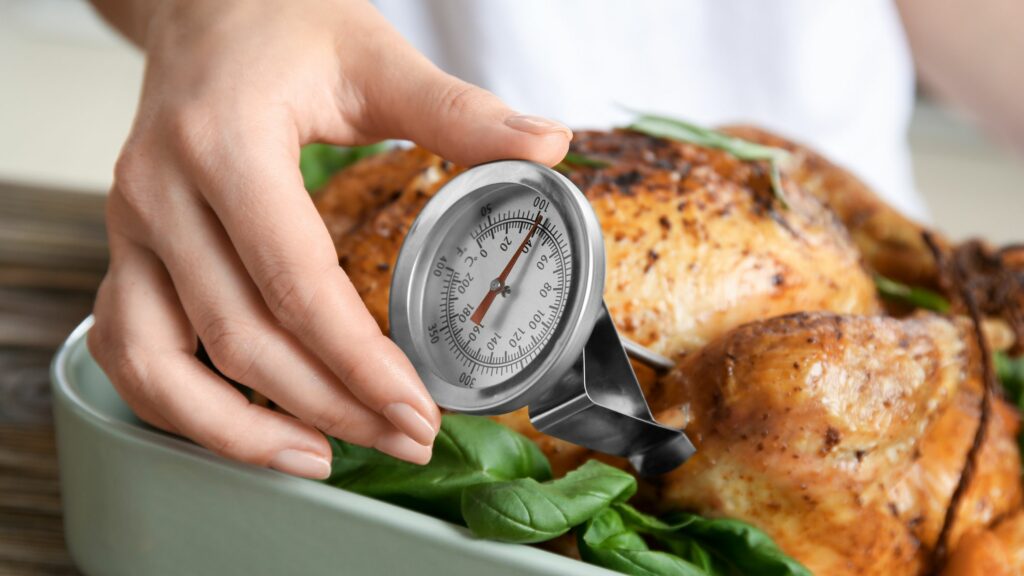
The meat thermometers have two types of probes: bimetallic strip thermometers and pop-up thermometers. The former has a stem that pops up when the temperature of the thigh reaches 185 degrees. The latter is a less reliable option, and the probe should stay in the meat throughout cooking.
Using a meat thermometer
When cooking chicken, using a meat thermometer can help you determine when the meat is cooked. The best way to do this is to poke it into the thickest part of the breast, away from the bone. You should also make sure that you do not touch the fat pockets or bone.
It may sound like overkill, but using a meat thermometer ensures that your chicken is cooked to the correct internal temperature. Master home cooks use them regularly. They eliminate the guesswork in cooking, ensuring food safety and flavor. Whether you’re frying a chicken or baking a whole chicken, a thermometer can help ensure your dinner is cooked correctly. For example, chicken should be cooked to a minimum of 165 degrees Fahrenheit. Meanwhile, ground meat and steak should be cooked to a minimum of 140 degrees Fahrenheit, so that they are able to release a great flavor.
A meat thermometer will also give you a visual display of the temperature of your meat. They are usually digital, with a long probe attached to a thin cable. Many meat thermometers can be programmed to the temperature you want, and alarms will sound when it reaches the target temperature. Some are even wireless, sending digital readouts to a phone or tablet.
Getting an accurate reading
A meat thermometer for chicken is a great tool that helps you determine the exact temperature of your chicken without risking overcooking it. The tip of the probe should be inserted into the thickest part of the meat to get the most accurate reading. You should be able to see the temperature change as you push the thermometer deeper into the meat. Also, make sure that the probe does not come into contact with bones or fat.
It is important to note that not all recipes are written equal. Even if the recipe you’re following does state the temperature, it might not be accurate. The internal temperature of a piece of meat is crucial for safety and flavor. Using a meat thermometer will allow you to accurately determine the temperature of the meat before you cut it. Ideally, chicken should reach an internal temperature of 165 degrees Fahrenheit, ground meat should reach 160 degrees Fahrenheit, and steak should be cooked to 145 degrees Fahrenheit.
When using a meat thermometer for chicken, make sure you insert the probe in the thickest part of the chicken, avoiding the bone. If the meat is not that thick, use it on the center of the meat.
Cleaning a meat thermometer
There are many ways to clean a meat thermometer for chicken. The first and easiest way is to use hot water and soap to clean the thermometer. Avoid using scouring pads or other materials that can scratch or damage the thermometer’s surface. After cleaning it, use a dry cloth to dry it completely. Bacteria can quickly multiply if the thermometer is not thoroughly dried.

When cleaning a meat thermometer for chicken, be careful not to touch the probe. This can bend the pins inside the thermometer and prevent it from working properly. You should also rinse the probe to remove any remaining soapy residue. Afterward, store your meat thermometer so that it will not come into contact with food.
If the meat thermometer is not dishwasher safe, you can clean it by cutting it in half with kitchen shears. Then, wipe off excess moisture with a damp paper towel. If the thermometer is still dirty, you can wash it in a chlorine bleach solution or boiling water. Always rinse it thoroughly before using it again to prevent bacteria from growing in it.

